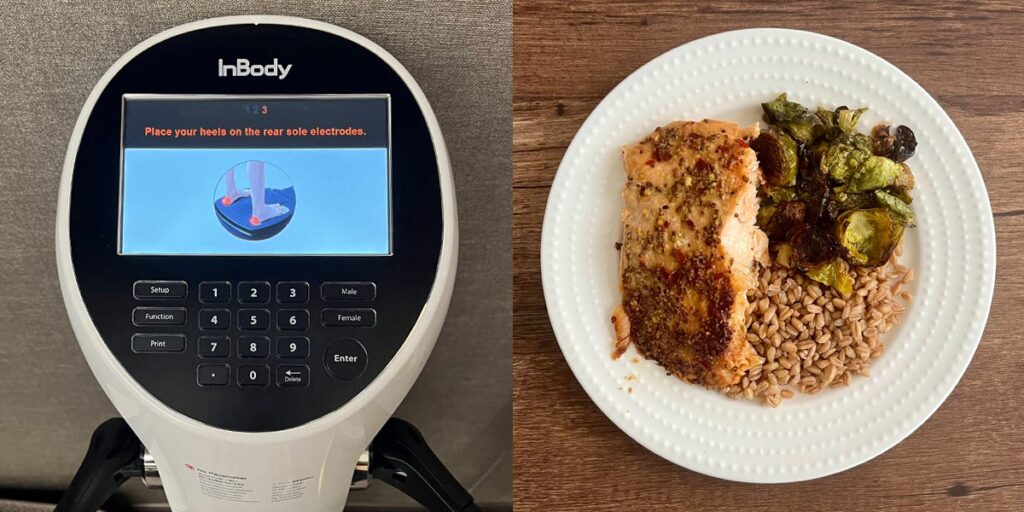- I got a body composition analysis through my gym, with a trainer explaining the results to me.
- While my BMI and muscle mass were in healthy ranges, my body fat was not.
- The results encouraged me to add more weights at the gym and drink more water.
If there was ever a time for me to scan my body for any health weaknesses, it was now. As the new year began, I got back into working out almost every day and kicked off Dry January.
I was ready: I booked a 30-minute body composition analysis at Life Time, a popular athletic club. A trainer met me and explained the process: I would take off my shoes and socks (of course when I forgot to repaint my toenails) and stand on an InBody body composition analyzer.
The scanning process took about five minutes. First, the machine weighed me, then scanned my skeletal muscle mass, body fat, and water content when I held the hand electrodes.
At first, my stats looked good. I quickly glanced at the printout and saw my BMI was in the healthy range. So was, to my pleasant surprise, my muscle mass — strength training seemed to pay off!
It was when he reviewed my body fat percentage that I panicked a little. I’d like to say it was an overdue wake-up call, but it was more a confirmation of what I already knew: I needed to change my routine.
The hot new trend of measuring body composition
The scanner, made by InBody, was first developed in South Korea in the late ’90s as an alternative to traditional scales. By the early 2000s, the first InBody body composition scanners hit the US market.
In 2020, InBody unveiled new technology at CES, a high-profile science conference. This update could ostensibly analyze abdominal fat and total body water, advancing the accuracy of body composition results.
In the years to follow, body composition scans became popular due to their ability to better measure overall health than BMI does.
An InBody 570, like the one I tried, can cost up to $15,000. Getting an InBody scan is considered to be a more affordable and convenient alternative to a DEXA scan, which uses X-ray images to measure how much muscle, fat, and bone you have. New DEXA scanners cost anywhere between $45,000 to $80,000 and can only be used by healthcare providers, while personal trainers can operate InBody machines.
DEXA scans are considered to be more accurate than InBody, which can produce skewed results if you eat right before, drink alcohol 24 hours before, or apply hand lotion.
BMI doesn’t tell the whole story
I’ve known for a long time that BMI isn’t a great health metric because it doesn’t separate the weight differences between muscle and fat.
Still, because mine was always in the “healthy” range, I used it as a quick barometer of my overall health, the same way I listen to my horoscope if it tells me I’m crushing it at life.
While my BMI and skeletal muscle weight were both in healthy ranges, my body fat percentage was slightly over the healthy limit. I also had the maximum healthy limit of visceral fat, fat stored near my internal organs.
Right now, my trainer said, I’m at a “crossroads” with my visceral body-fat ratio. It’s still easy enough for me to reverse through diet and more challenging exercise. But if it keeps increasing, he said I’ll be at a higher risk for developing heart disease later on in life, even if my BMI remains the same.
The analysis gave me targets for how much body fat to lose and muscle to gain to be maximally fit. Knowing my body, hitting those targets would require me to essentially live at the gym and be incredibly strict with my diet, two things I’m not willing to do.
However, I agree with the broader goal: lose some body fat and gain a little bit of muscle, which requires monitoring my diet and getting my heart rate up at the gym.
My diet needs work
My trainer said that most of the work will be in my diet, meaning I would need a calorie deficit. He said I should prioritize whole foods like lean protein, fruits, vegetables, and grains, essentially following the Mediterranean diet.
I’ve already been focused on getting more protein and eating enough plant-based foods. My breakfast is either oatmeal with berries and peanut butter or scrambled eggs. Every week, I meal-prep some variation of fish with vegetables and grains. Even when I make pasta at home, it’s always whole wheat with a homemade sauce.
When the new year started, I cut alcohol to improve my health, something that will definitely help me lose body fat. I’ve also been working on eating smaller portions. When I was training for a marathon or preparing to deadlift my heaviest, I got into the habit of eating a lot more than I used to. Now that I’m not doing either, all that extra food is being converted into fat I’m not burning off.
I still have room for improvement. He said I should drink more water, which can help with fat loss. Reflecting on my diet, I could be more mindful about how many little treats I give myself in a day (probably should be less than three!). Given his emphasis on unprocessed foods, I knew I had to tweak my diet to include more fruits and vegetables.
The same day I got the assessment, I texted my husband: our comfort dinner of miso-butter pasta was going to come with some salad.
Heart rate is key
When I started running a decade ago, I quickly dropped about 15 pounds without changing much about my diet.
More recently, I started going to strength classes about two to three times a week, and running between two and five miles on the other days, with usually one rest day. I also live in a city, so I often walk or bike to get places.
Done together, I thought this would keep me lean and healthy.
My trainer explained that it isn’t so simple: if I’m more leisurely with my runs (which I am), I’m not getting my heart rate up high enough to burn fat. It matters less that I can run a marathon than how fast I can go.
The same thing goes for strength training: if I’m not actively increasing the weight I lift, I’m not building enough muscle to experience the fat-burning benefits.
When I had a strength training class later that day, I challenged myself to sprint more in the running portion and lift heavier on my bench press.
Additionally, I wrote down my weights so I could track my improvement.
A few days later, I chose to join a faster pace group in my run club. It was challenging, but doable — exactly what the trainer said I should aim for.
He also said HIIT classes could help me burn fat and gain muscle, so I’m planning to try one soon.
While it initially stung to hear that I wasn’t in as excellent health as I thought, I also learned how in control I am of my body. I was already working on fine-tuning my eating habits and gym routine. The body composition analysis is just there to remind me why I do it.
Read the full article here
















